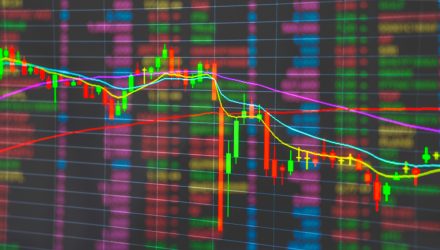The low volatility factor and dividend stocks often intersect because the latter often display favorable traits of the former. However, not all strategies for marrying these two important concepts are created equal. In fact, some can subject investors to unpleasant surprises.
Conversely, the WisdomTree U.S. LargeCap Dividend Fund (NYSEArca: DLN) stands in an environment of rampant negative dividend action and at a time when many low volatility stocks are richly valued.
DLN, which is featured in some of WisdomTree’s model portfolios, seeks to track the price and yield performance, before fees and expenses, of the WisdomTree U.S. LargeCap Dividend Index. The index is a fundamentally weighted index that is comprised of the large-capitalization segment of the U.S. dividend-paying market.
stands in an environment of rampant negative dividend action and at a time when many low volatility stocks are richly valued.
DLN, which is featured in some of WisdomTree’s model portfolios, seeks to track the price and yield performance, before fees and expenses, of the WisdomTree U.S. LargeCap Dividend Index. The index is a fundamentally weighted index that is comprised of the large-capitalization segment of the U.S. dividend-paying market.
DLN Benefits
DLN offers some value exposure without subjecting investors to elevated volatility, potentially taking some of the risks out of paying up for low volatility stocks.
“For now, dividends for the sector appear safe to us, providing a key level of near-term valuation support. But, nonetheless, “low vol” investing has become expensive,” said Scott Welch, Chief Investment Officer of WisdomTree model portfolios, in a note.”
DLN offers some value exposure without subjecting investors to elevated volatility, potentially taking some of the risks out of paying up for” low volatility stocks.
“For now, dividends for the sector appear safe to us, providing a key level of near-term valuation support. But, nonetheless, “low vol” investing has become expensive,” said Scott Welch, Chief Investment Officer of WisdomTree model portfolios, in a note. “Put differently, investors seem willing to “pay up” for a low-volatility allocation within their portfolio, but, as we know, the future potential performance of any investment is a function of how much you pay for it today. If you pay a high multiple today, your future potential performance typically is reduced.”
While DLN has a value tilt, it’s not excessively allocated to familiar value sectors. For example, financial services and energy stocks, which are offering little in the way of dividend growth this year, combine for just 19% of the fund’s roster.
Overall, energy, consumer discretionary, and real estate – three of the worst sectors for negative dividend action, combine for about 16% of DLN’s weight. Specific to real estate, that’s usually considered a low volatility group, but it’s been stung by the coronavirus pandemic, forcing a spate of dividend cuts and suspensions while resulting in elevated turbulence.
“But we believe we may have entered a new market regime, driven by both the ongoing pandemic and corresponding governmental intervention, that will be characterized by increased volatility,” said Welch. “For advisors seeking to improve the risk factor diversification of their overall portfolio and thereby potentially lowering portfolio volatility—but without ‘paying up’ for ‘low volatility’ securities—the WisdomTree multifactor models may be worth looking into.”
Another DLN perk: it has a combined weight of more than 35% to the technology and healthcare sectors, which have been delivering payout growth this year.
For more on multi-asset strategies, please visit our Multi-Asset Channel.
The opinions and forecasts expressed herein are solely those of Tom Lydon, and may not actually come to pass. Information on this site should not be used or construed as an offer to sell, a solicitation of an offer to buy, or a recommendation for any product.








